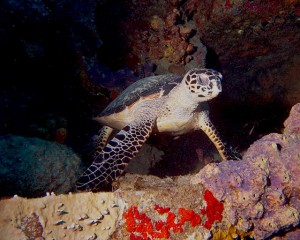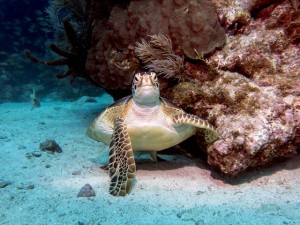Part of the fascination with scuba is the ability to temporarily exist within the marine world that is filled with creatures of all shapes and sizes. Everyone has their favorites and despite the allure of the “big stuff”, you also learn to appreciate the tiny fish and other marine life that you find on the reefs and in the sand. With that said though, turtles are among the ones that divers keep an eye out for and always enjoy. The green sea turtle is the most common in this area along with the hawksbill and you can see loggerheads and leatherbacks. There is a species called the Kemp’s Ridley, but it is really rare and I don’t personally know of anyone who has ever seen one in the wild.
The trick to diving with turtles is to try and curb your excitement when you see one. If it has plenty of air and doesn’t perceive you as a threat, it will often swim slowly, allowing you to keep pace. There is something special about being able to do that and yes, you do occasionally lose sight of where the boat is if you’re following a turtle. It’s worth having an extra distance to swim back. Turtles can be easily impacted by trash though and monofilament line, straws, plastic bags and plastic rings like that hold a six pack of beverages together are among some of the worst common items that people carelessly toss into the water. The fishing line and plastic rings can snare a turtle’s flippers, literally trapping it underwater or tightening into the skin enough to cut it. Turtles eat jellyfish among other things and plastic bags or straws can look like food. Once ingested, plastics can’t be digested and that causes all sorts of problems. So please, if you are on or around the water, be extra careful with your trash and make sure it’s placed in a secure bin. We love our turtles and want to do everything we can to keep them safe.



